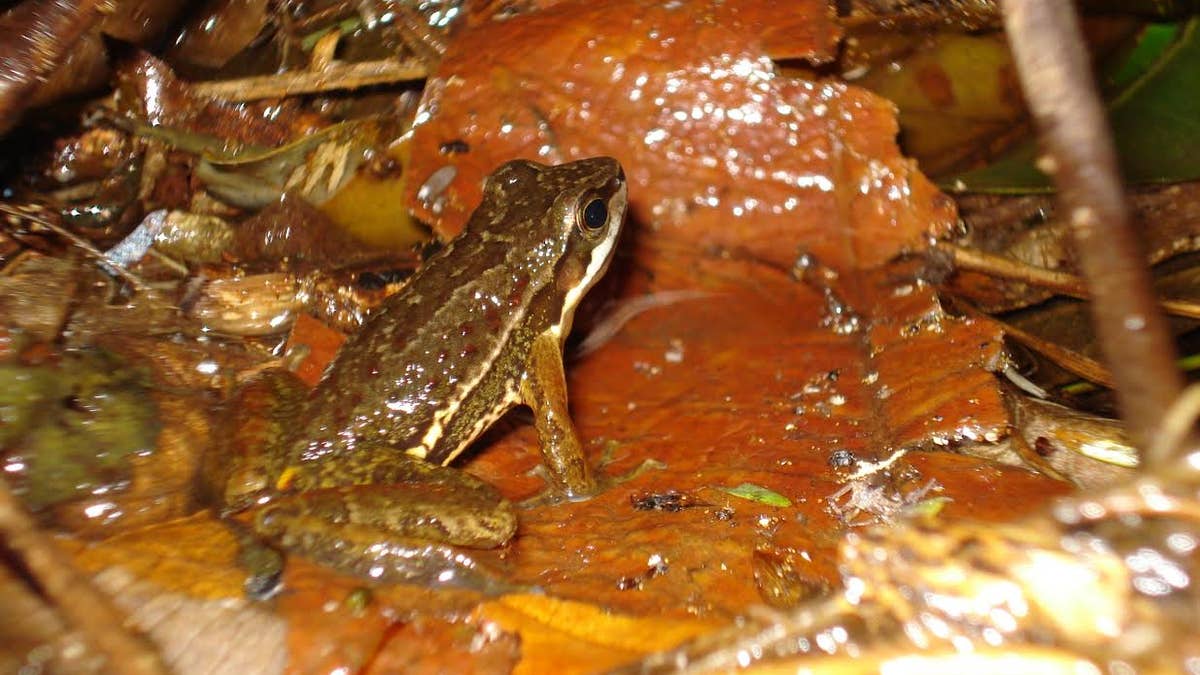
Hylodes japi (Fábio de Sá)
Much like a couple in a noisy city, one species of frog has to do plenty to catch the eye of a prospective mate.
It’s not the roar or the subway or the honk of the taxis that is the distraction but rumbling streambeds in Brazil that is the problem. To overcome the racket, the Brazilian torrent frogs (Hylodes japi) turns to sophisticated collection of visual and audio cues – including inflating vocal sacs, squealing, and even waiving their limbs - to stand out from the crowd.
Related: Mini frog, bat with freakish tongue found in Bolivia
The males using their toes, feet, hands, legs, arms, vocal sacs, head, and body while females aren’t as active - only displaying their hands, arms, and body. The brown and reddish brown frogs have as many as 18 movements in their arsenal, as described by Fábio P. de Sá of the Universidade Estadual Paulista in Brazil and his colleagues, including body jerking, truncated walking, head bobbing and the two-armed impulse.
And in a display never before been seen in frogs, females use a combination of visual displays including lifting their arms and touching the male, which prompt the male's courtship call. The females also have a series of displays – including lifting her arm – as a sign she has given the male the green light.
Related: Deadly fungus could threaten US salamanders
“It is always exciting to observe new behaviors in the field. We did not expect that the species had all those behaviors, so we are glad to be communicating our findings,” said de Sá, whose team observed the courtship behavior in the 70 male and female torrent frogs in the biological reserve of Serra do Japi for a study that appeared this month in PLOS ONE.
“Hylodes japi is a small and very secretive frog species. It is easy to hear their calls in the Forest, but not easy to see them,” de Sá said told FoxNews.com in an email interview. “It was a pleasure when we could get behavioral data -- specially when male and female were interacting during courtship.”
Related: Kermit the cannibal? Frogs sometimes eat each other
The displays, in the cases of the males, varied depending on whether they felt they were competing for a mate or had her all to themselves. Considered incredibly territorial, the frog, for example, would resort to a technique called toe trembling –wiggling or twitching a toe- if it felt the presence of an invader or toes posture – holding the foot up for a few seconds.
The authors acknowledge that multimodal signal as it’s called has been documented in wolf spiders, fish, squirrels and even birds. And of late, there has been a greater appreciation of the courtship displays of frogs – which long had been thought to attract a mate simply with their vocal calls. Other frog species in noisy environments have also shown to have a bag of visual tricks, including Hylodes asper from Brazil, the Micrixalus saxicola from India and the Staurious parvus from Borneo.
Related: New jelly-bean-size 'masked' frog discovered in the Andes
“New records of visual signals are being constantly detected for nocturnal and diurnal frog species; in our discussion we suggest that visual communication in frogs is more widespread than previously expected,” de Sá said.
“In the tropics, we have a higher number of frog species and a higher number of phylogenetic groups of frogs associated to a higher environmental complexity,” he said. “We suggest that this combination facilitates a higher behavioral complexity as well. These are important points and, in the future, can provide base for the understanding of the evolution of vertebrates' communication. “




















